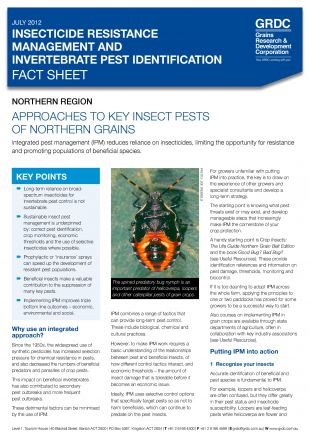Insecticide resistance management and invertebrate pest identification
Published: 1 Jul 2012
Approaches to key insect pests of Northern grains
Key points
- Long-term reliance on broad spectrum insecticides for invertebrate pest control is not sustainable.
- Sustainable insect pest management is underpinned by: correct pest identification, crop monitoring, economic thresholds and the use of selective insecticides where possible.
- Prophylactic or ‘insurance’ sprays can speed up the development of resistant pest populations.
- Beneficial insects make a valuable contribution to the suppression of many key pests.
- Implementing IPM improves triple bottom line outcomes – economic, environmental and social.
Approaches to key insect pests of Southern and Western grains
Key points
- Prophylactic or ‘insurance’ sprays can be an unnecessary cost and may speed up the development of resistance in pest populations.
- Consider carefully the need for insecticides. There may be beneficial insects present that will help control pests if crops are left unsprayed.
- IPM uses cultural, chemical, genetic and biological tactics to prevent pests from reaching damaging levels in crops.
- Only apply insecticides after monitoring and correctly identifying pest species.
- If insecticides are used, minimise chemical impact on beneficial insects by considering a selective spray and limited number of applications.
- Rotate chemical classes with different modes of action to minimise resistance problems. Use the correct rates and ensure good coverage.
- Base the choice of control strategies on economic thresholds.
Download PDF
Table of contents
- Insecticide Resistance Management and Invertebrate Pest Identification Southern and Western.pdf (PDF 358.3 KB) Southern and Western edition
- Insecticide Resistance Management and Invertebrate Pest Identification Northern.pdf (PDF 357.3 KB) Northern edition
Region: North; South; West
GRDC Project Code: DAQ00153,
Was this page helpful?
YOUR FEEDBACK
To protect your privacy, please do not include contact information in your feedback. If you would like
a response, please contact us.

